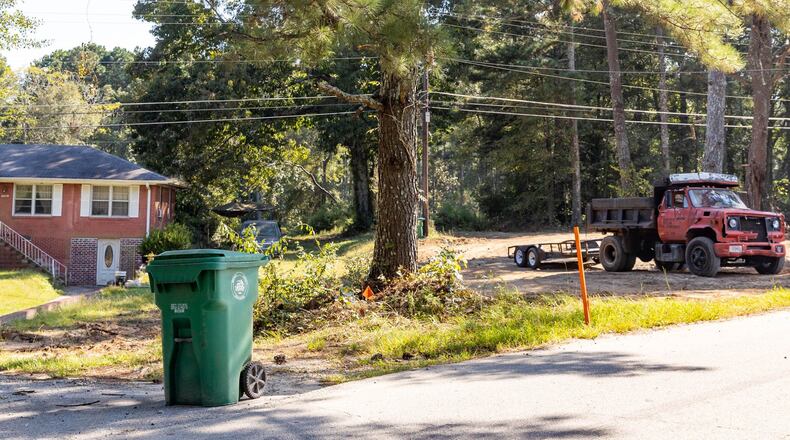Correction: An earlier version of this story said Stonecrest’s zoning code includes an 150-foot buffer between industrial and residential properties. Depending on the specific industrial use, it varies from 75 to 150 feet.
Southeast DeKalb County is one of metro Atlanta’s longstanding industrial hubs, often to the irritation of residents who have to share winding roads with diesel trucks and hear train horn blasts.
But recent headlines and protests about a recycling plant that was approved within earshot of homes has energized city leaders to tackle the problem through tighter zoning rules. They point to an outdated zoning code and a lack of long-term planning decades ago as the source of many ongoing conflicts.
The Metro Green Recycling plant and Duke Realty’s failed bid for a large distribution center are among the industrial projects proposed near existing neighborhoods that have run into heavy opposition from nearby residents. Claims of environmental racism have also been raised because most neighborhoods near the industrial lands are majority Black.
“DeKalb County was using this area as basically their dumping ground,” Darien Senior, who moved to the Rogers Crossing subdivision in 2003, said. “… Finding that out after (moving here) was like, ‘Uh oh. You’ve got to be kidding me.’”
Senior and other residents hoped things would change when Stonecrest was founded in 2016, creating a city that’s now about 94% African American. However, problems have persisted and emotions often boil over at city meetings.
Jim Summerbell, Stonecrest’s planning director, said the city’s zoning code, which was copied from DeKalb when the city was founded, encourages these conflicts by incentivizing residential developers to build near historic industrial areas.
“There’s certain uses you don’t want to have in any community,” he said. “It just heightens the potential for problems. It doesn’t give you the image that you want to have.”
The Metro Green Recycling plant has become the poster-child for the county’s industrial versus residential conflict. A DeKalb judge recently ordered work to stop at the concrete recycling plant due to legal questions about how the company received government approval to build the facility so close to homes.
“What we should be thinking about really and truly is the separation of industrial from residential,” Councilman Jimmy Clanton said during a Sept. 17 work session about zoning. “That’s the whole Metro Green issue. We shouldn’t do anything to encourage industrial use near residential. Point, blank, period.”
‘Folks that pay the freight’
With easy access to I-20, the Lithonia-Stonecrest area has been an industrial corridor for more than half a century. Those industrial roots, which include rock quarries, landfills and trucking facilities, generate tax revenue and employ thousands. In Stonecrest, industrial land makes up more than 13% of the city’s acreage.
“The folks that pay the freight are commercial and industrial,” Mayor Jason Lary said Sept. 17. “But the folks that vote are of course residential. So you want to try to have a happy medium between those three areas of concern, and I think that would cut down on a tremendous amount of angst anytime something tries to come to the City of Stonecrest.”
In 1979, DeKalb commissioners began rezoning vacant industrial lots to residential, including several plots that are now in Stonecrest.
Several of those places, such as Coffee and Maddox roads, are now primarily dilapidated houses surrounded by gravel parking lots for trucks. Some residential properties appear to be parking for dump trucks or other construction vehicles. City leaders are considering reverting some of those properties back to industrial.
“If it’s clear they’re not being used for residential purposes and they’ve not maintained it, why not?” Summerbell said. “… I would be surprised if you could really find investors that would be interested in building a residence right there.”
Credit: Jenni Girtman
Credit: Jenni Girtman
Identifying problem areas
The city has been trying to spot areas where residential parcels border industrial ones to try to prevent future conflicts.
The Stonecrest Industrial Council, founded earlier this year, consists of several business owners who have been active in southeast DeKalb’s industrial community for decades. They provided the city with a map of six potential problem areas in the northern portion of the city limits.
Senior and those in the Rogers Crossing subdivision live in one of those areas. His primary concern is the number of trucks that already use the two-lane road outside his neighborhood.
“It’s quite treacherous at times due to the fact that you have trucks that are broken down or they’re hugging the side to drop off their loads and you don’t see them on a blind curve,” Senior, a Rogers Crossing homeowners’ associations board member, said.
The Stonecrest Industrial Council said forming a community improvement district (CID), an area that levies extra taxes to improve infrastructure, could pay for to improve the area. In addition, city leaders applied to the Atlanta Regional Commission for a program that would evaluate the city’s road infrastructure and provide new funding opportunities.
“This stuff isn’t cheap,” Summerbell said. “Anytime you deal with trying to improve the street right of way, sidewalks and streetscapes, it comes with a price tag.”
Credit: Jenni Girtman
Credit: Jenni Girtman
Who bears the burden?
Buffer zones are currently the city’s primary tool to try to separate industrial and residential properties. However, industrial facilities that have been around for decades often don’t have buffers in place.
“Whoever is new to the situation, we’re trying to come up with a way where they would be required to help build that buffer,” Summerbell said. Current code calls for buffers varying from 75 to 150 feet, but the council is discussing potentially increasing those requirements.
From the other side of the coin, residential developers have gotten pushback from residents when trying to build homes next to existing industrial areas. In the past few months, residents voiced their opposition to multiple townhome projects that would abut industrial areas or take up land intended for mixed-use projects. Summerbell said the city could require those residential developers to obtain a special land use permit (SLUP), exposing them to another layer of public scrutiny.
Renee Cail, president of a citizen-activist group that protested the Metro Green project, said neighbors are tired of only getting industrial projects and isolated residential developments. She said she’d like to see commercial businesses and mixed-use projects come to town rather than more trucking facilities, factories and townhomes.
“I know industrial facilities have to be built,” she said. “But I don’t think that they should be built in neighborhoods where it’s going to disturb the quality of life for people.”
The city is considering removing several industrial uses that Summerbell called “obnoxious” from the city’s code — such as dry cleaning plants, explosives manufacturing, radioactive materials and metal smelting.
The logistics, manufacturing and trucking industries are continuing to expand in Stonecrest — Home Depot recently opened a massive distribution center in the city. However, residents hope the city’s zoning code rewrite, which Summerbell plans to make progress on by the end of 2021, will help give them further protection.
“The city and surrounding areas have plenty of industries,” Cail said. “But if there’s more (industrial) spaces in the city that won’t negatively impact the residents, I’m OK with that if it’s far enough away.”
About the Author
The Latest
Featured





